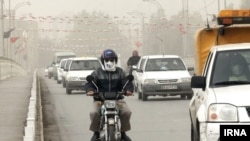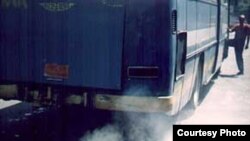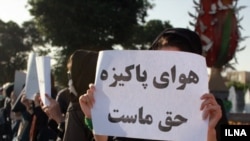While air pollution has forced schools and sports arenas to stay closed in Tehran for the fourth consecutive day, the head of the Islamic Republic’s environmental agency insisted that the air quality elsewhere in Iran such as the cities of Ahvaz, Tabriz, and Urmia is much worse.
Talking to reporters on December 20, Issa Kalantari referred to “incomplete combustion” as the major factor in Iran's air pollution.
“The only factor in polluting cities’ air is the existence of fine particles [with a width] smaller than 2.5 micron (PM2.5), produced by incomplete combustion," Kalantari affirmed.
According to U.S. Department of Health, “There are outdoor and indoor sources of fine particles. Outside, fine particles primarily come from car, truck, bus, and off-road vehicle (e.g., construction equipment, snowmobile, locomotive) exhausts, other operations that involve the burning of fuels such as wood, heating oil, or coal, and natural sources such as forest and grass fires."
Blaming worn-out vehicles, Kalantari dismissed the generally accepted concept that dust particles, nitrogen oxide, and Sulphur oxide have a role in polluting the air.
“Incomplete combustion of heavy vehicles, worn-out trucks, buses, and motorbikes is the main factor in polluting the air," Kalantari said.
Old vehicles, specially trucks and heavy machinery is a major problem in Iran. The Islamic Republic has imposed heavy import duties for decades and a lot of red-tape and, limiting the import of new vehicles and machinery.
In Tehran, one big problem is the city's old buses. Sixty seven percent of the buses in Iran’s capital are fatigued and beyond their "useful life", a City Council member reported on Friday, September 15.
In addition, an environmental expert, Esmail Kahrom told Radio Farda that due to lack of sufficient inspection stations, vehicles are not inspected as often as in other countries and the process is spotty, leading to the existence of many polluting vehicles on the road.
He also added that lack of winds and precipitation have led to what is called inversion, keeping pollutants hanging over major urban areas.
On December 16, the city of Tabriz, northwestern Iran, was officially declared the most polluted city in the country.
Tehran has an additional factor, which creates pollution more often throughout the year; industrial concentration.
It is estimated that around 30% of Iran's industry is located in and around the capital city, which has grown to a sprawling urban center with 20 million population - 13 million in the city and 7 million in nearby suburbs and towns.
According to an expert at Meteorological Agency, air pollution will continue for at least another five days across Iran.
Iranians have suffered various types of air pollution in recent years. Last year, 4,810 residents in Tehran died because of air pollution, IRGC-run news agency Tasnim cited an official as saying.
Meanwhile, another IRGC-run news agency, Fars, reported, “Tehran’s air pollution in recent days has doubled the number of heart attacks in the country.”
On December 19, Kalantari admitted the government is helpless in confronting the problem.
“We should pray for winds to blow away the pollution," Kalantari concluded.






